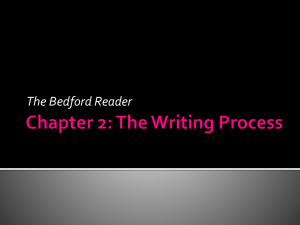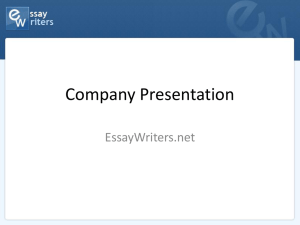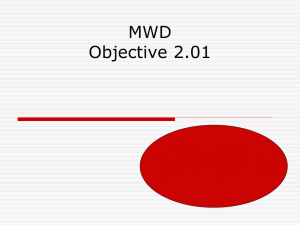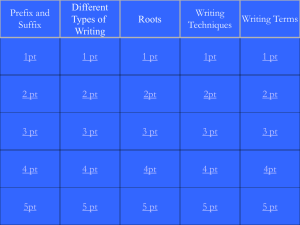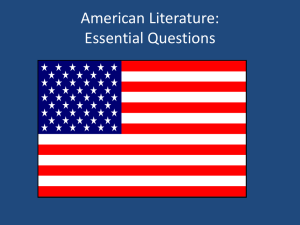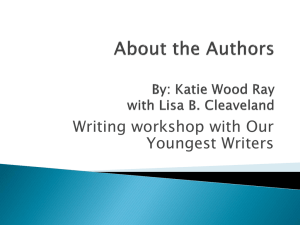Agricultural Communications
advertisement
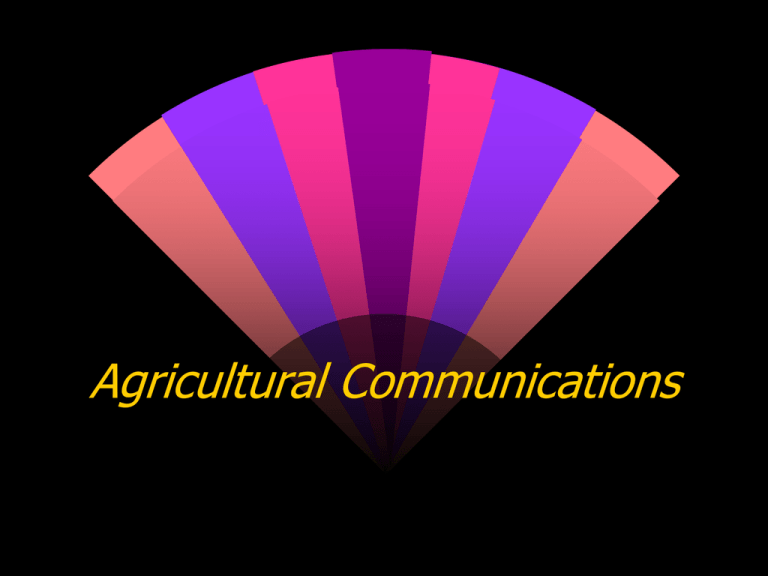
Agricultural Communications Agricultural Communications I. Communications Project Proposal and Presentation Each team will prepare a communications project proposal for their chapter. The proposal will explain the communications activities planned to publicize an event/issue. The proposal will be submitted before the national CDE. At the national meeting, the team will make an oral presentation of the proposal. Agricultural Communications II. Test A. Editing exercise Because editing is a critical skill for all communicators, each team member will complete an editing exercise. They will be given a printed document that contains 25 mistakes. In correcting the mistakes, team members will be required to use correct proofreader’s marks (see Associated Press Stylebook and Libel Manual). Style, grammar, punctuation and spelling mistakes will be included. Team members will NOT be able to use the style manual or dictionary during this exercise. Agricultural Communications II. Test B. Communications quiz Each team member will complete a quiz that covers basic elements important to the skill areas of journalistic writing and broadcasting, public relations writing, and graphic design. Five questions will be written for each segment, which includes broadcast, public relations, news, visuals, and ethics of communication. Team members will NOT be able to use the style manual or dictionary during this exercise. Agricultural Communications III. Practicums The practicums will consist of four individual events. Each team member will be assigned to one of the following activities. Each team should assign a member to each of these activities before arriving at the national event. Agricultural Communications III. Practicums Newswriters--- Organizing and writing a news story. Press release Writer---Organizing and writing a press release. Broadcaster----Developing and carrying out a broadcast. Graphic Designer--- Preparing a graphic and editing photos for a news story. News writers Students are to write a news story based on information gathered at the news conference. It should be written for an agriculture publication (ag producer) audience. The story should have a minimum of 250 words and follow news or inverted pyramid style. It should have a strong focus and lead (opening paragraph). The story should provide answers to who, what, when, where and why. Students also should write a headline for their story. Each writer can use notes from the press conference, the Q&A session, and from information in the press packet. After writers arrive in their designated room, they will have 60 minutes to complete their task. The release will be word processed by the student on a computer, printed out and turned in to be scored. Judging based on written communication skills, accuracy, organization, style, creativity and grammar. Press release writers Each press release writer will use the press packet and the information gathered in the press conference to write a 200- to 300-word press release excluding the words in the header. The release should be written as if it were being distributed by the expert's company or organization. The release will be word processed on a computer, printed out and turned in to be scored. Once the press release writers arrive in the computer room, they will have 60 minutes to complete the task. Broadcasters Each broadcaster will use the press packet and information gathered in the press conference to write and carry out a two-minute radio broadcast suitable to be aired on a radio station or radio network. After the contestant has developed the story, he or she will use a standard cassette and tape recorder to broadcast the story. The cassette with the recorded broadcast will be turned in to be evaluated. Students will be able to listen to their recording prior to turning in the cassette if time allows. All tape recorders will be the same, therefore, recording quality will not be a factor in the evaluation process. Broadcasters will also develop and turn in five written questions that he or she would have asked the expert if they were given the opportunity to interview the expert after the press conference. These written questions will be turned in along with the cassette once the student has completed the tasks. After the broadcasters arrive in their designated room, they will have 60 minutes to complete their tasks. Graphic Designers Each graphic designer will complete a graphic art, photo editing, and photo caption writing exercise. Effective communication or information sharing through visual tools is the objective. After graphic designers arrive in their designated room, they will have 60 minutes to complete their two tasks. Each of these tasks are described below. Graphic art exercise--Each student creates a chart or table on a computer that illustrates numeric data from the press conference. A press packet (including news release and data) is provided for each artist. Students are judged on their graphic art skill, understanding and use of statistics and creativity. Photo editing exercise--Students will receive a variety of black & white photos (5x7 prints) and will be asked to select the best photo to use in a story based on the news conference. Each student should make photo cropping suggestions by marking the photo borders with a wax pencil. Each student is to give oral reasons on why they selected a particular photo. These reasons should include the photo's best qualities, its visual appeal to readers, and how it helps communicate the story's message. Photo caption writing exercise--Students are to write a twoline caption (approximately 25 words) for their selected photo. Students will be judged on accuracy of information, grammar, brevity, clarity and creativity of captions. Agricultural Communications Press Conference All teams will meet in a central location for an orientation and press conference. Teams will be divided so that all broadcasters sit together, all news writers sit together, all press release writers sit together and all graphic designers sit together. All team members will be given an orientation at the beginning of the practicums to last no more than 10 minutes. Agricultural Communications Press Conference Following the orientation, the press conference will be held. Each team member will receive a press packet with background information on the agricultural topic and expert to use during the event. An expert will speak on a timely agricultural topic for 20 minutes. Students will be provided with paper to take notes on if they wish. Students should bring their own pens or pencils. Agricultural Communications Press Conference After the 20-minute presentation, the broadcasters and graphic designers will be dismissed to a different area to complete their assigned tasks. (See detailed descriptions of assignments later in rules.) Agricultural Communications Press Conference The news writers and press release writers will then be involved in a 10-minute question and answer period with the expert (speaker). Only news writers will be allowed to ask the questions. Each news writer will stand to be recognized before asking a question. News writers may ask more than one question; however, the expert will attempt to address questions from as many different contestants as possible. All news writers and press release writers may take notes during the question and answer period, but only news writers will be allowed to ask questions of the expert. Agricultural Communications Press Conference Upon completion of the 10-minute question and answer session, the news writers and press release writers will be dismissed to a computer room to complete their assigned tasks. Overall CDE Timeline and Schedule: 1. Communication plan presentation -- 15 minutes 2. Tests (editing exercise and quiz) -30 minutes 3. Practicum -- 1 hour and 40 minutes Total = 2 hour 25 minutes COMMUNICATION PROJECT PROPOSAL Rationale Objectives of project Target audiences to address Key messages Media selection Budget Evaluation criteria Grammar, punctuation, spelling, style 25 25 20 15 20 10 15 20 TOTAL 150 COMMUNICATION PROJECT PRESENTATION Professionalism appearance (official dress), poise and posture, attitude/confidence, demeanor, ethical concerns 10 Knowledge of subject 20 Power of expression directness, sincerity, emphasis 10 Verbal skills grammar, voice (quality, pitch, articulation, pronunciation, force) 10 CONTINUE COMMUNICATION PROJECT PRESENTATION Questions and Answers ability to answer questions on the presentations which are asked by judges indicating originality, familiarity with subject and ability to think quickly. 50 Supporting Evidence examples that document the materials used to develop the project 25 Creativity and innovation 25 TOTAL 150 TESTS Communications Quiz 100 (25 points per team member) Editing Exercise 100 (25 points per team member PRACTICUMS News stories Lead/focus Organization, brevity, conciseness, and clarity Correct style Accuracy of information and quotes Creativity Headline Grammar, spelling, punctuation, word choice 20 15 10 20 10 10 15 SUBTOTAL 100 Press releases Lead/focus Organization, brevity, concise and clarity Correct style Accuracy of information and quotes Creativity Header/headline Grammar, spelling, punctuation, word choice Company or product information 20 15 10 15 5 10 15 10 SUBTOTAL 100 Broadcasters' recordings Voice quality Power of expression Lead/focus Clarity of communication Organization, concise and brevity Creativity Accuracy of information and quotes Quality of five written follow-up questions 10 10 15 10 10 10 15 20 SUBTOTAL 100 Visual Communication Graphic art skill 20 Understanding and use of statistics 15 Creativity 15 Photo editing 20 Reasons (critical thinking) 15 Photo caption writing 15 SUBTOTAL 100 Total Practicum Score 400 TOTAL TEAM SCORE Practicum scores Communications project proposal Project presentation Test scores 400 150 150 200 TOTAL 900 II) Tie Breakers A. Team tie breakers will be settled in the following order: 1. Proposal score 2. Practicum scores 3. Presentation score B. Individuals tie breakers will be settled in the following order: 1. Practicum score 2. Quiz score 3. Editing exercise score
